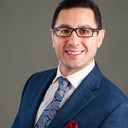The element that looks "Roman"-y to me is that the upper part of your nose, just in front of your eyes, is strong in its forward projection. The part just *above* the "bump" that sits in the middle part of your bridge. More on that later...






